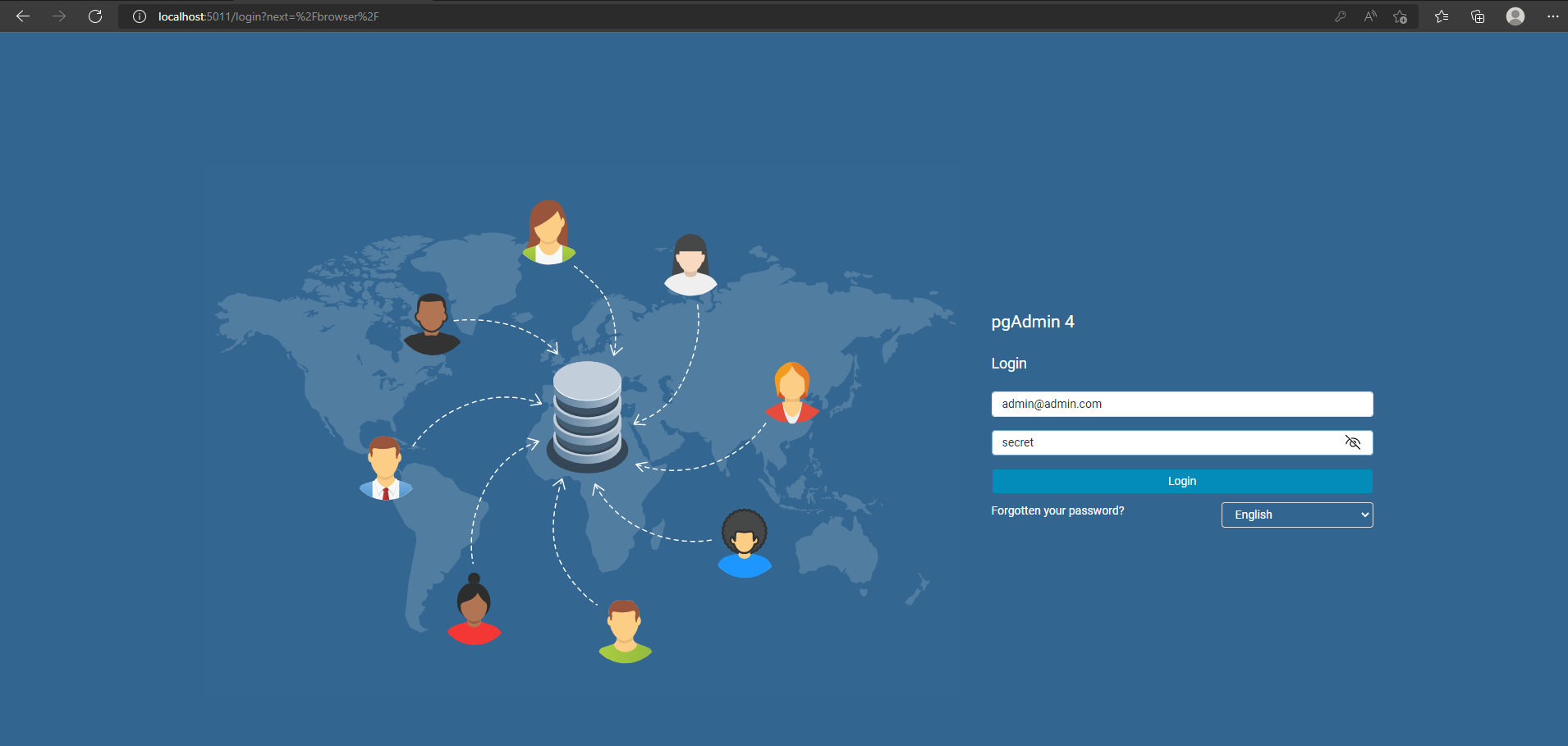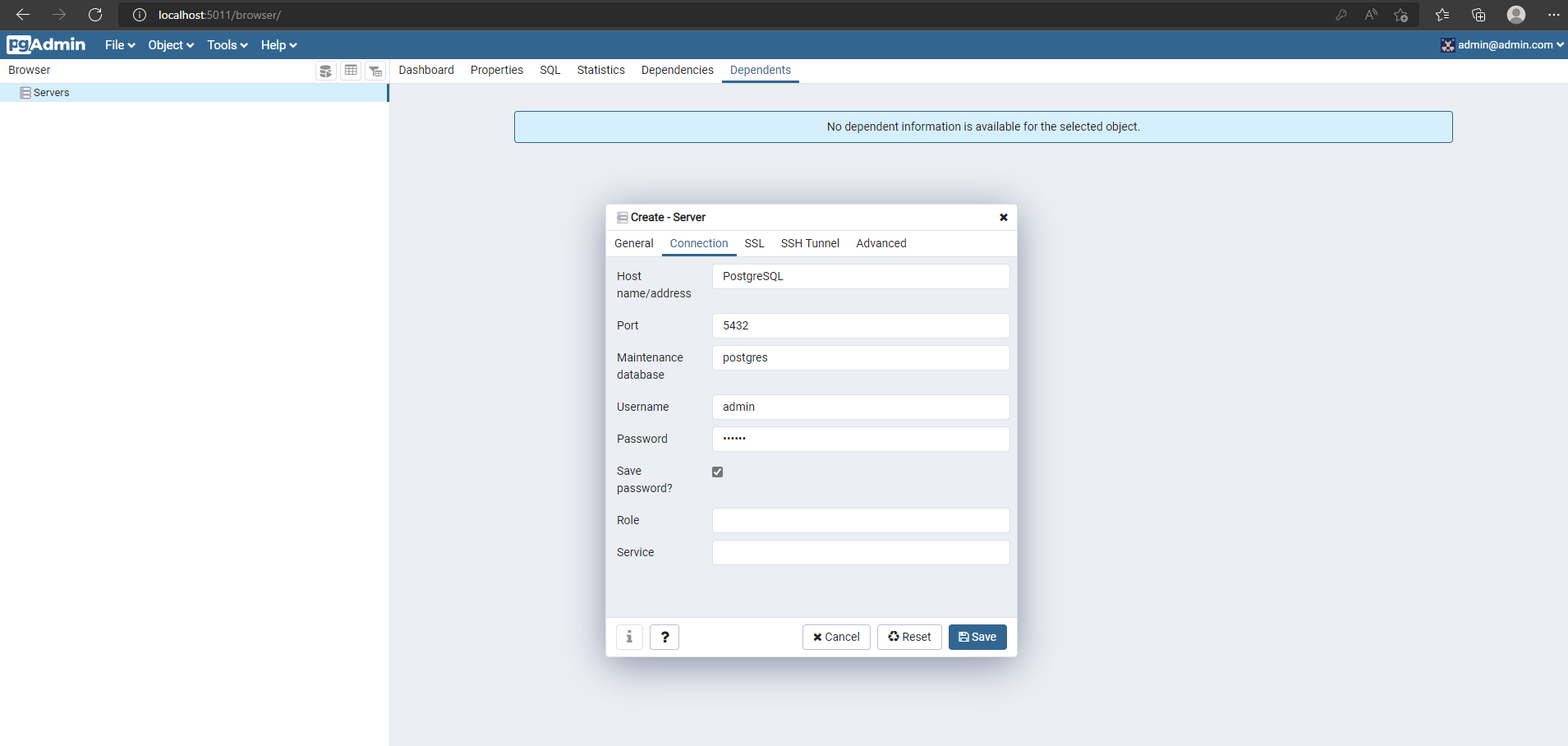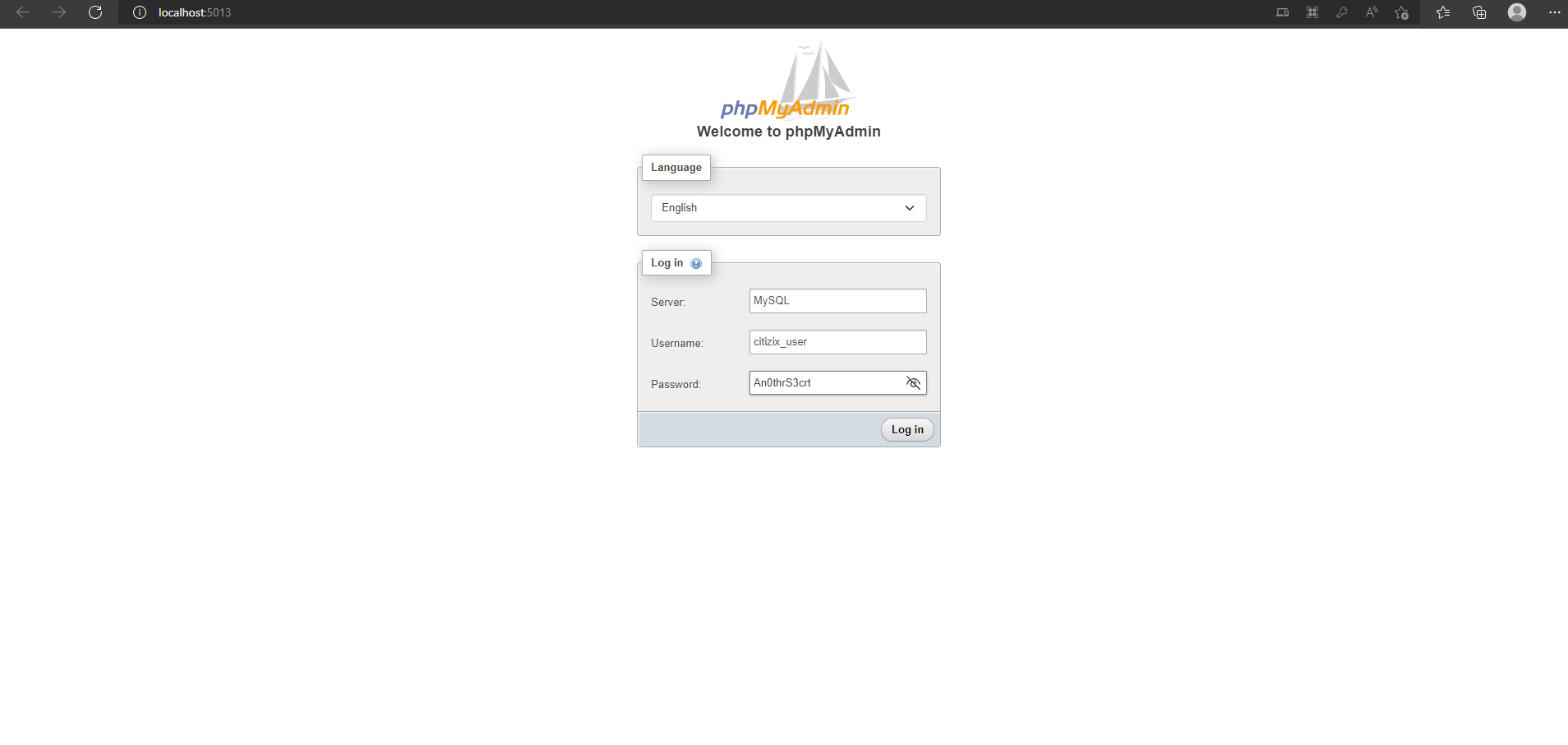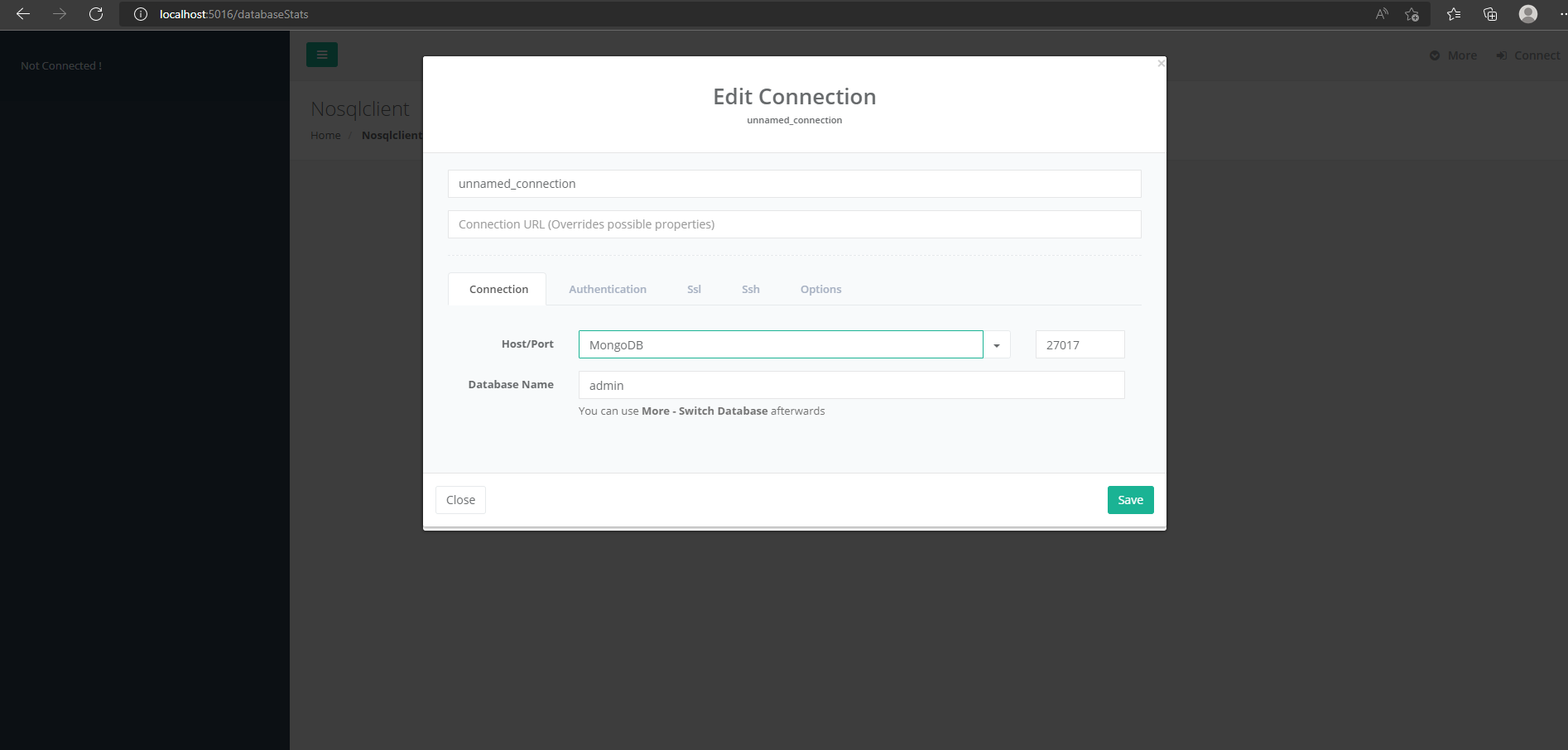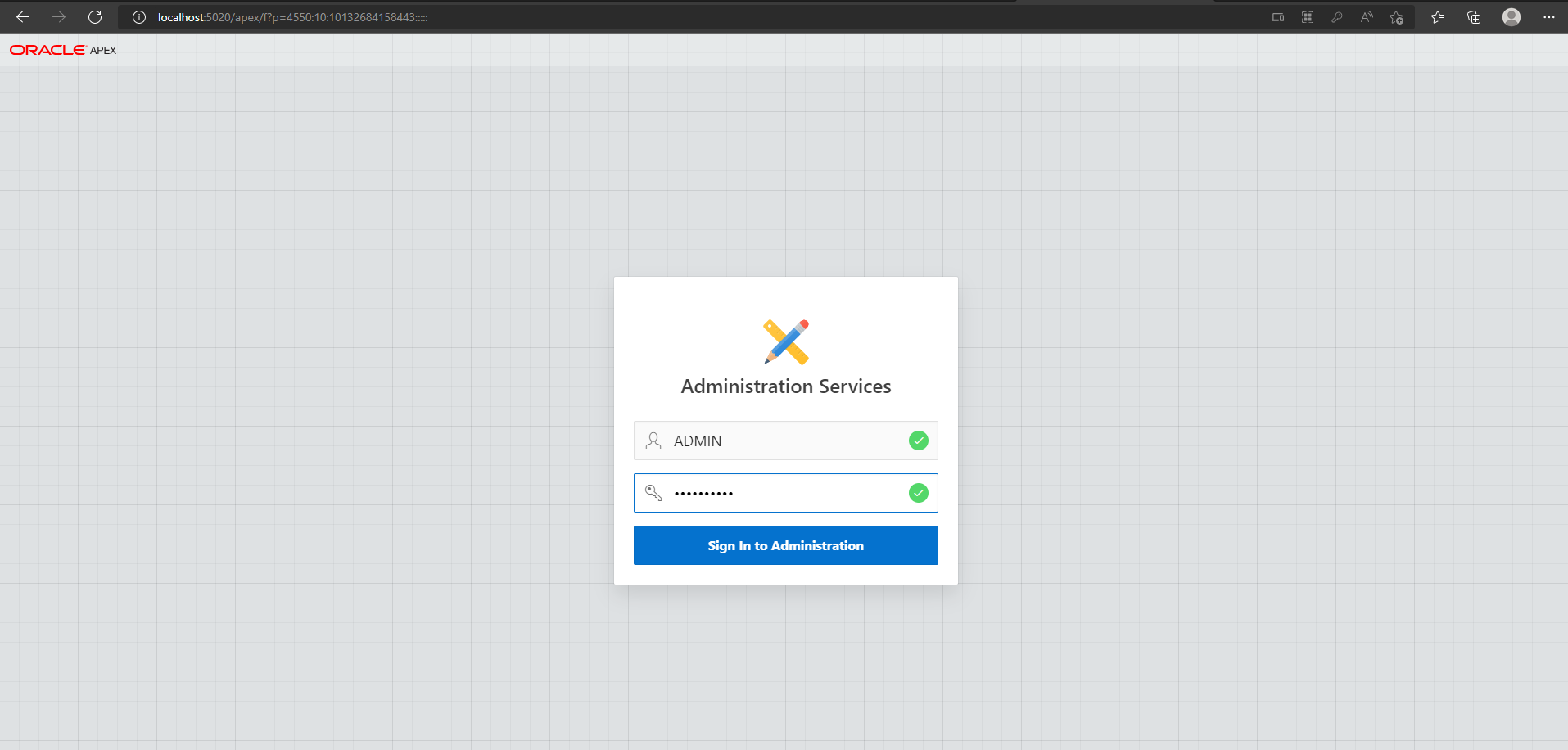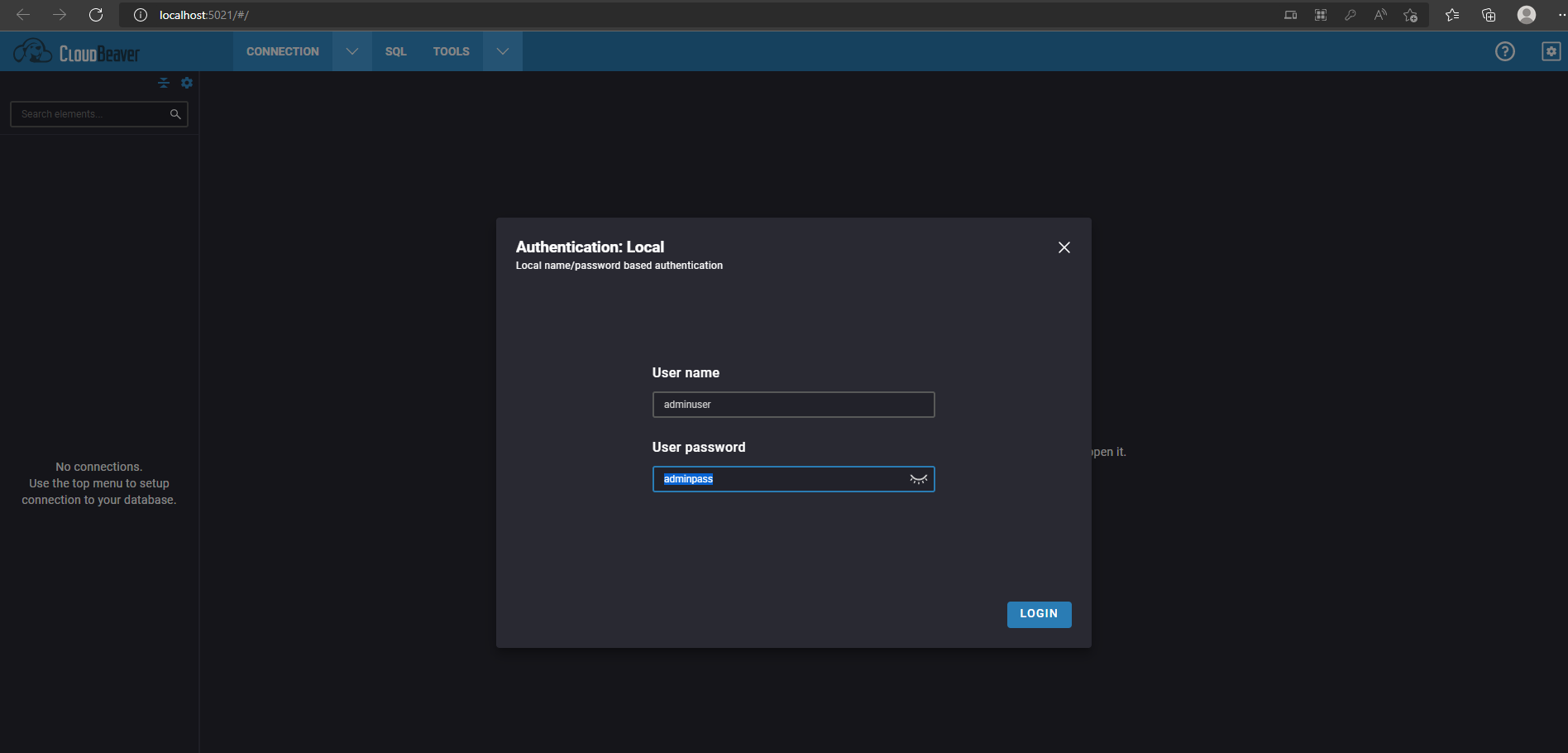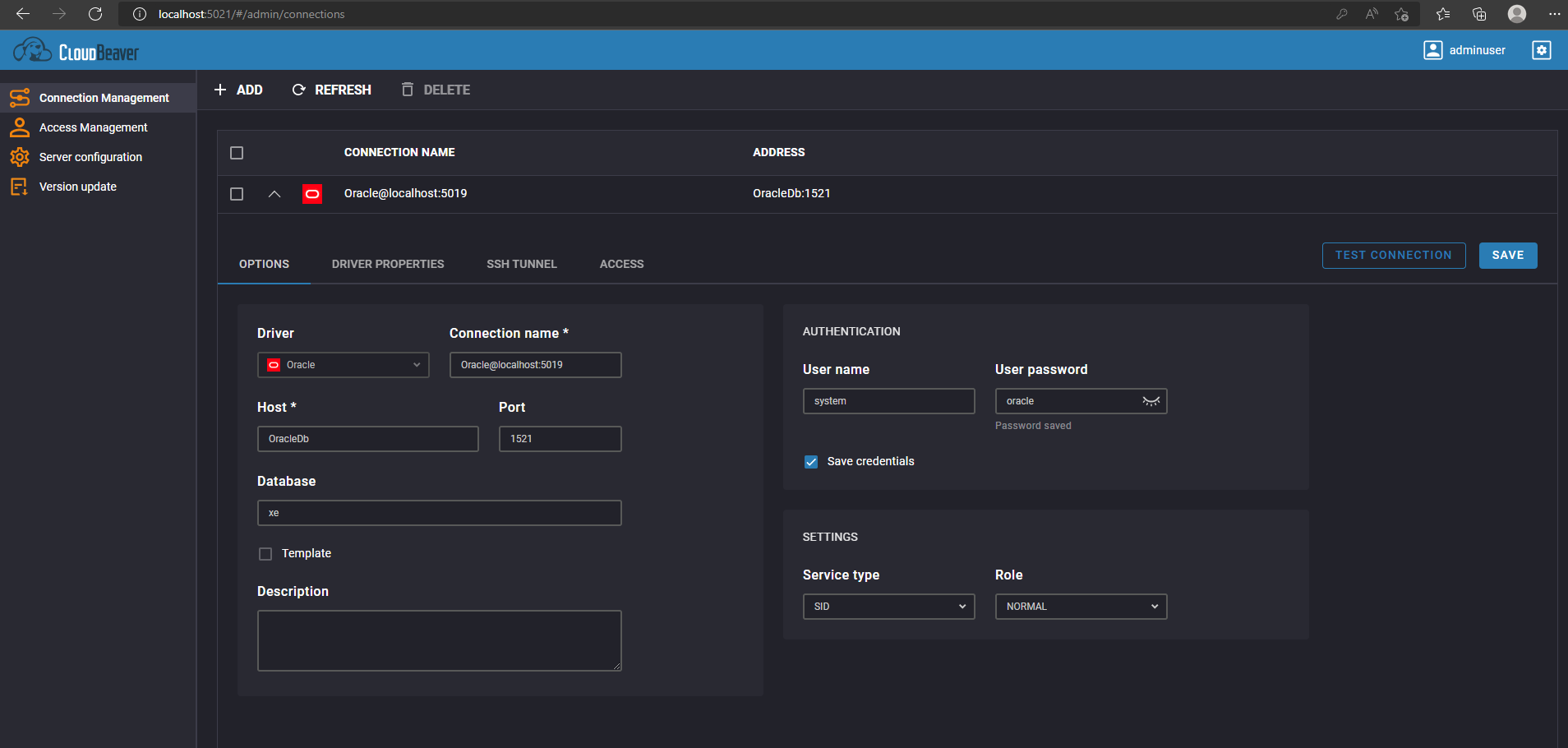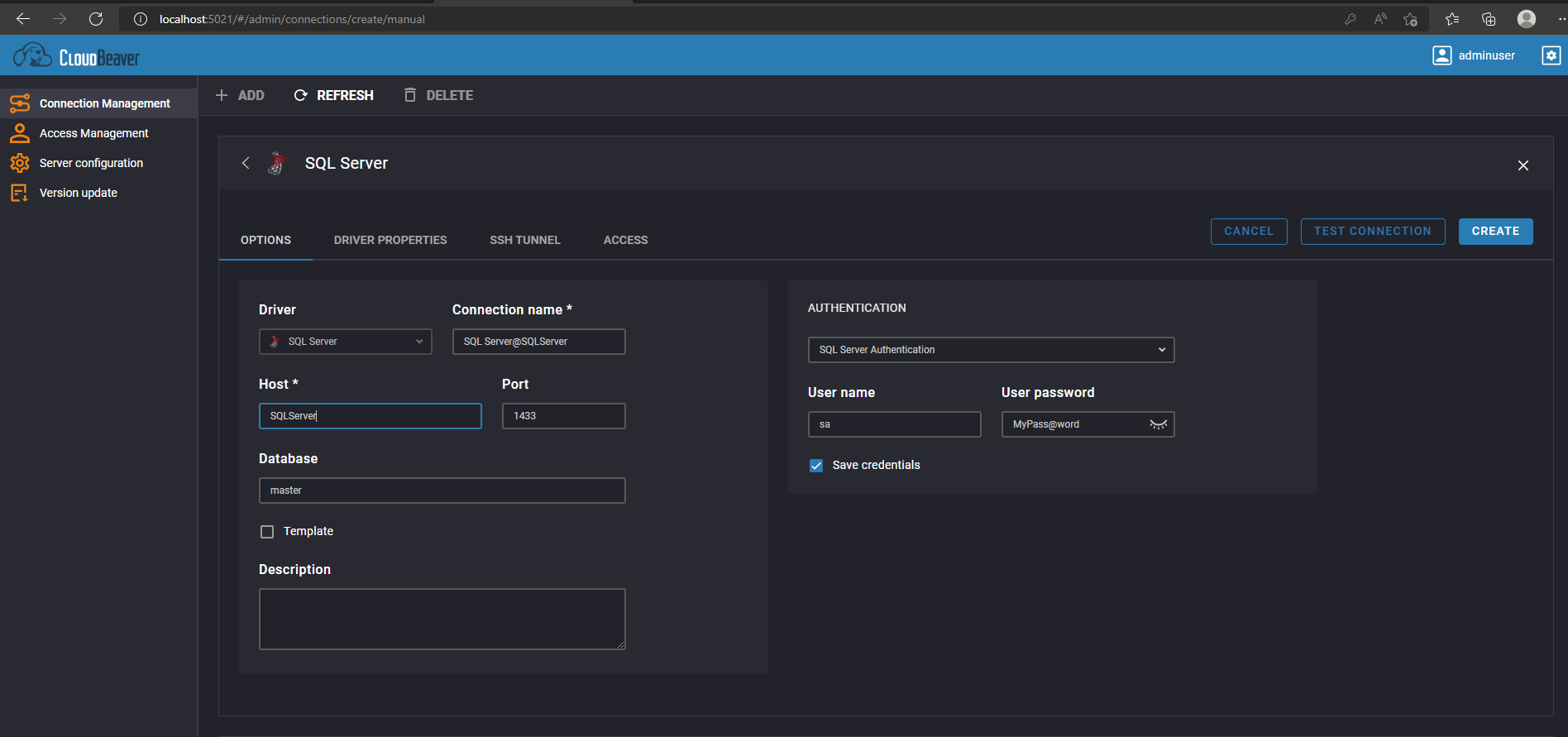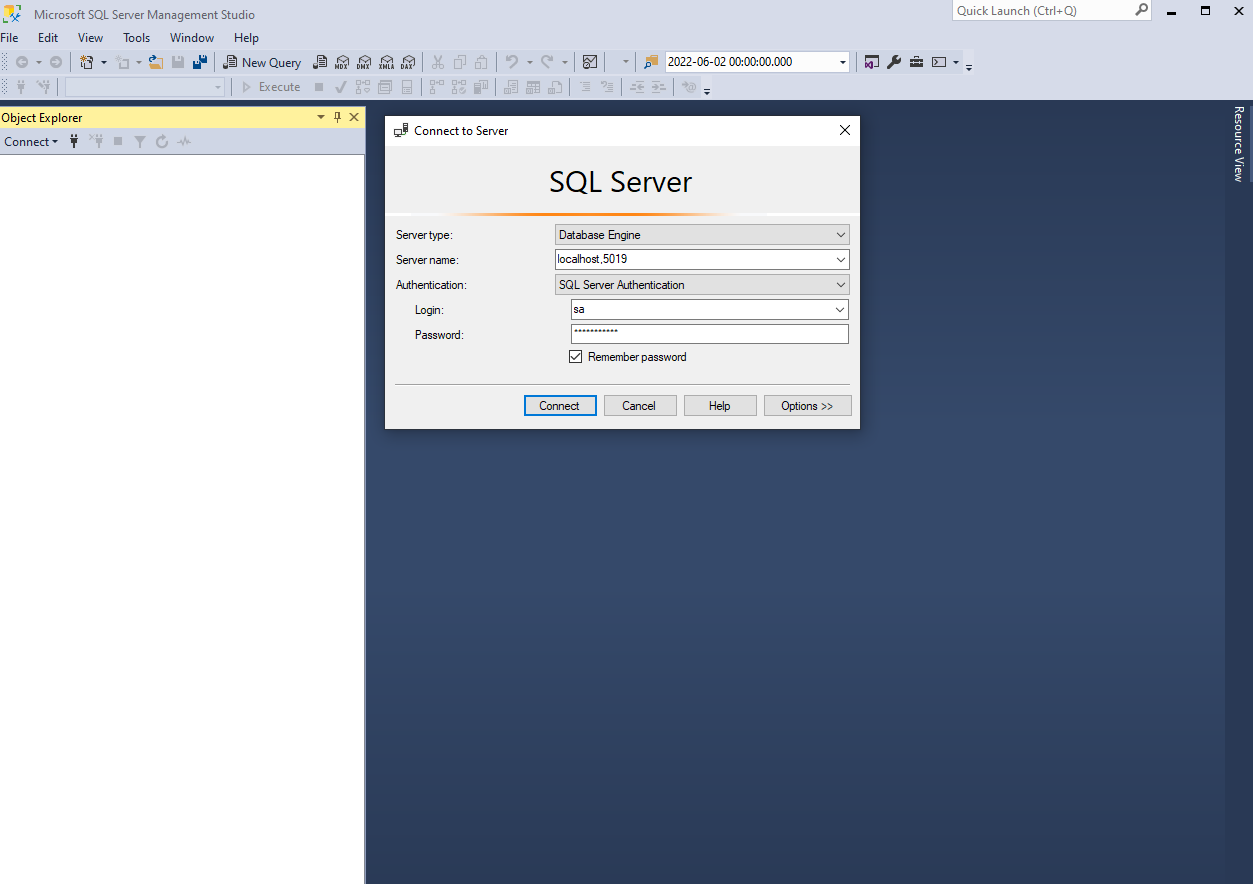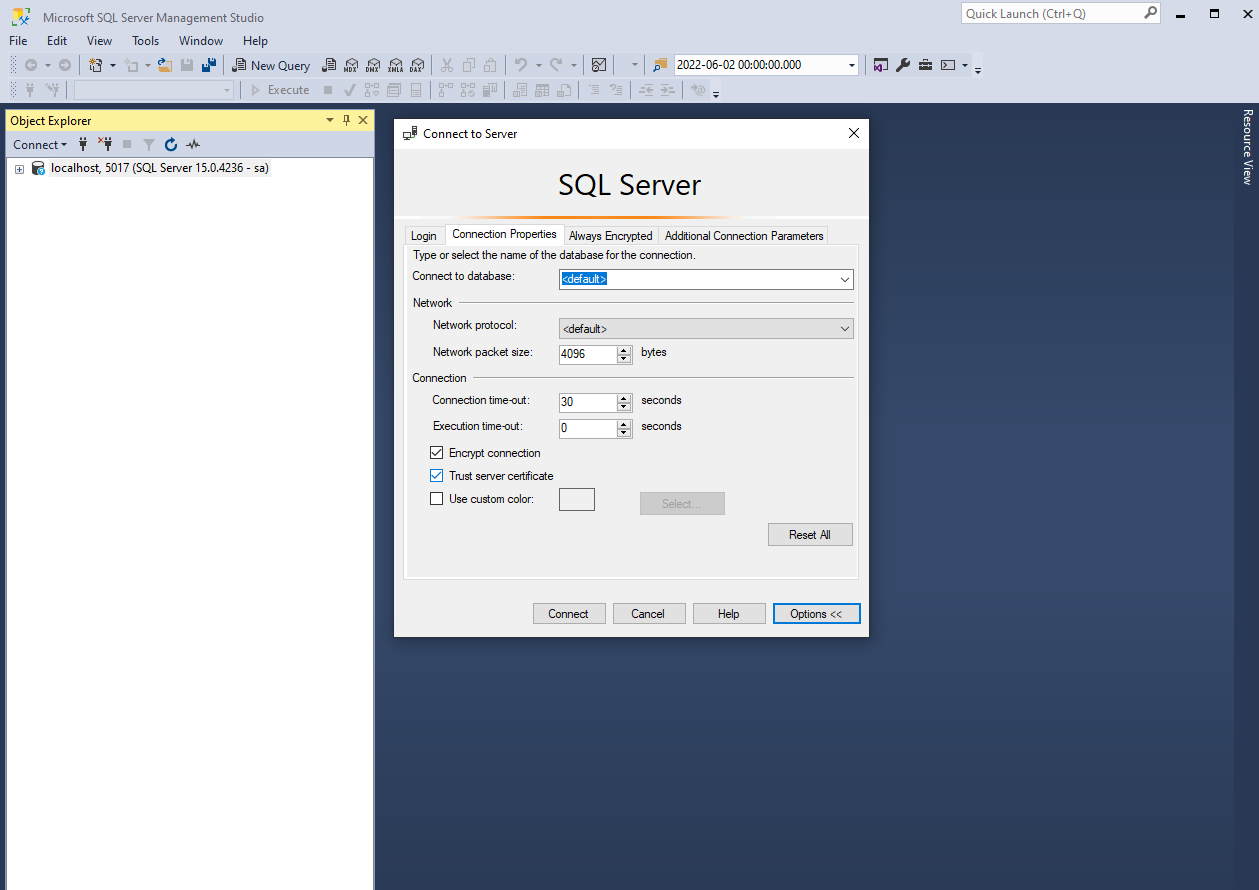Run Database and GUI Clients in Docker
5.00/5 (8 votes)
Quick start example to run DB and clients in docker
Background
When setting up a new project, there is sometimes a comprehensive list of prerequisites to be able to run the project, this could lead us to use multiple databases even different versions. Docker is great for running local databases in a development environment. Here, we will explore docker-compose.yml files to set up multiple DB and GUI clients in docker. This will be a very quick and basic workaround considering multiple databases.
Things we need:
- Docker installed locally
- Basic Docker knowledge
- Experiences using DB
- Experiences using the GUI clients
PostgreSQL
Database: PostgreSQL
GUI Client: pgAdmin
This will create a database named postgres in the Db instance with credentials admin and secret.
version: "3.7"
services:
pgsql:
image: postgres:12.2
container_name: PostgreSQL
restart: always
environment:
POSTGRES_DB: postgres
POSTGRES_USER: admin
POSTGRES_PASSWORD: secret
PGDATA: /var/lib/postgresql/data
volumes:
- pgsql-data:/var/lib/postgresql/data
ports:
- 5010:5432
pgadmin:
image: dpage/pgadmin4:4.18
container_name: PgAdmin
restart: always
environment:
PGADMIN_DEFAULT_EMAIL: admin@admin.com
PGADMIN_DEFAULT_PASSWORD: secret
PGADMIN_LISTEN_PORT: 80
ports:
- 5011:80
volumes:
- pgadmin-data:/var/lib/pgadmin
links:
- pgsql:pgsql-server
volumes:
pgsql-data:
pgadmin-data:
Client
pdAdmin will be available at http://localhost:5011/login.
admin@admin.com and secret as credential.
Access Db
Host name or Server as DB container name PostgreSQL.
Port 5432
DB credentials admin and secret
MySQL
Database: MySQL
GUI Client: phpMyAdmin
This will create a database named quotes in the Db instance with credentials citizix_user and An0thrS3crt:
version: "3.7"
services:
mysql:
image: mysql:8.0
container_name: MySQL
restart: always
cap_add:
- SYS_NICE
environment:
- MYSQL_DATABASE=quotes
- MYSQL_USER=citizix_user
- MYSQL_PASSWORD=An0thrS3crt
- MYSQL_ROOT_PASSWORD=mauFJcuf5dhRMQrjj
volumes:
- mysql-data:/var/lib/mysql
ports:
- 5012:3306
phpmyadmin:
image: phpmyadmin:5.2.0
container_name: PhpMyAdmin
restart: always
ports:
- 5013:80
environment:
- PMA_ARBITRARY=1
volumes:
mysql-data:
Another GUI Client: MySQL Workbench
version: "3.7"
services:
mysql-workbench:
image: lscr.io/linuxserver/mysql-workbench:8.0.29
container_name: MySQL-Workbench
environment:
- PUID=1000
- PGID=1000
- TZ=Europe/London
volumes:
- mysql-workbench-data:/config
ports:
- 5014:3000
cap_add:
- IPC_LOCK
restart: unless-stopped
volumes:
mysql-workbench-data:
Server name as DB container name MySQL and other DB credentials.
Client
PhpMyAdmin will be available at http://localhost:5013/.
Access Db
Server name as DB container name MySQL
DB credentials citizix_user and An0thrS3crt
MongoDB
Database: MongoDB
GUI Client: Nosqlclient
This will create a database named chats in the Db instance without credentials.
version: '3.7'
services:
mongo:
image: mongo:4.4.2
container_name: MongoDB
restart: always
environment:
- MONGO_INITDB_DATABASE=chats
ports:
- 5015:27017
volumes:
- mongodb-data:/data/db
mongo_client:
image: mongoclient/mongoclient:4.0.1
container_name: Nosqlclient
restart: always
depends_on:
- mongo
ports:
- 5016:3000
volumes:
mongodb-data:
Client
Nosqlclient will be available at http://localhost:5016/
Access Db
Host name as DB container name MongoDB
Port 27017
We can also use connection string like mongodb://userName:password@containerName:27017/dbname
Oracle
Database: Oracle
GUI Client: CloudBeaver
This will create a Db instance with credentials.
version: '3.7'
services:
oracle:
image: wnameless/oracle-xe-11g-r2:18.04-apex
container_name: OracleDb
restart: always
environment:
- ORACLE_ALLOW_REMOTE=true
- ORACLE_DISABLE_ASYNCH_IO=true
- ORACLE_ENABLE_XDB=true
ports:
- 5019:1521
- 5020:8080
dbeaver:
image: dbeaver/cloudbeaver:22.1.1
container_name: CloudBeaver
restart: unless-stopped
volumes:
- dbeaver-data:/opt/cloudbeaver/workspace
ports:
- 5021:8978
volumes:
dbeaver-data:
Oracle APEX
http://localhost:5020/apex/apex_admin
username: ADMIN
password: Oracle_11g
Client
CloudBeaver will be available at http://localhost:5021/
Initially, it will ask to set a credential so I used adminuser and adminpass.
Access Db
Host name as DB container name OracleDb
Port 1521
Db or sid xe
DB credentials system and oracle
SQLServer
Database: SQLServer
GUI Client: CloudBeaver
This will create a Db instance with credentials.
version: '3.7'
services:
sqlserver:
image: mcr.microsoft.com/mssql/server:2019-latest
container_name: SQLServer
restart: always
environment:
- ACCEPT_EULA=Y
- MSSQL_PID=Express
- SA_PASSWORD=MyPass@word #user sa
#volumes:
#- sqlserver-data:/var/opt/mssql/data #not working in windows
#- "./sqlserver-data/:/var/opt/mssql/data" #this working in windows
ports:
- 5017:1433
Client
Same like Oracle
Access Db
Host name as DB container name SQLServer
Port 1433
Db(default) master
DB credentials sa and MyPass@word
Access Db Using Management Studio
Server name localhost, 5017
Credentials sa and MyPass@word
Set TrustServerCertificate = True (https://stackoverflow.com/a/50504551/2948523)
MariaDB
Database: MariaDB
This will create a database named quotes in the Db instance with credentials citizix_user and An0thrS3crt.
version: "3.7"
services:
maria:
image: mariadb:10.6
container_name: MariaDB
restart: always
environment:
- MARIADB_DATABASE=quotes
- MARIADB_USER=citizix_user
- MARIADB_PASSWORD=An0thrS3crt
- MARIADB_ROOT_PASSWORD=mauFJcuf5dhRMQrjj
volumes:
- maria-data:/var/lib/mysql
ports:
- 5018:3306
volumes:
maria-data:
Client
PhpMyAdmin or CloudBeaver
Access Db
Server name as DB container name MariaDB.
DB credentials citizix_user and An0thrS3crt
Others
Commands
PostgreSQL
docker-compose -f docker-compose.pgsql.yml up -d
MySQL
docker-compose -f docker-compose.mysql.yml up -d
docker-compose -f docker-compose.mysql.workbench.yml up -d
MongoDB
docker-compose -f docker-compose.mongo.yml up -d
SQLServer
docker-compose -f docker-compose.sqlserver.yml up -d
MariaDB
docker-compose -f docker-compose.maria.yml up -d
Oracle
docker-compose -f docker-compose.oracle.yml up -d
Ports
5010, 5011 pgsql
5012, 5013, 5014 mysql
5015, 5016 mongo
5017 sqlserver
5018 maria
5019, 5020, 5021 oracle
Check Database Version
Here are a few SQL queries to check our working database versions:
SELECT @@VERSION; /*sql server*/ /*also works with mysql*/
SELECT * FROM V$VERSION; /*oracle*/
SELECT VERSION(); /*mysql*/ /*also works with postgre*/
SELECT VERSION(); /*mariadb*/
SELECT VERSION(); /*postgre sql*/ /*also works with mysql*/
Online Playground
Coming Up
- SQLite
- Set credentials for MongoDB
- Use multiple DB in the same instance
History
- 6th July, 2022: Initial version

